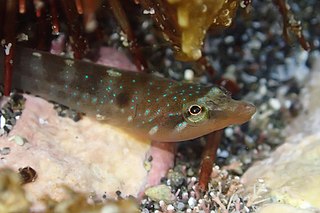
The New Zealand urchin clingfish is a clingfish. It is found around New Zealand wherever sea urchins are present. Its length is between 2 and 3 cm.
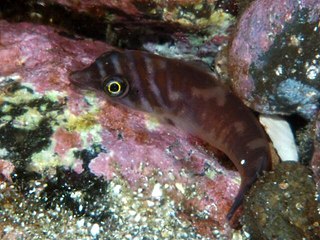
Clingfishes are fishes of the family Gobiesocidae, the only family in the order Gobiesociformes. These fairly small to very small fishes are widespread in tropical and temperate regions, mostly near the coast, but a few species in deeper seas or fresh water. Most species shelter in shallow reefs or seagrass beds, clinging to rocks, algae and seagrass leaves with their sucking disc, a structure on their chest.

Dellichthys is a small genus of clingfishes from the family Gobiesocidae which are endemic to New Zealand. It had been regarded as a monotypic genus but a second species was described in 2018.

The shore clingfish is a clingfish of the family Gobiesocidae. It is found in the Mediterranean Sea and adjacent Atlantic Ocean north to Galicia, Spain.

Acyrtus is a genus of clingfishes found in the western Atlantic Ocean.

Apletodon is a genus of marine fish in the family Gobiesocidae (clingfishes). The genus was first named by John Carmon Briggs in 1955.
Derilissus is a genus of clingfishes belonging to the family Gobiesocinae found in the western Atlantic Ocean. This family of fish is identified by their appearance as small fish with sucking discs which allow them to attach themselves to various surfaces. Derilissus differs from other genera due to its attached gill membranes.

Diplecogaster is a genus of fish in the family Gobiesocidae found in Black Sea, Mediterranean Sea and Atlantic Ocean.

Gobiesox is a genus of clingfishes found in the Americas, including offshore islands. Most species inhabit coastal marine and brackish waters, but G. lanceolatus is a deep-water species found at a depth of around 300 m (980 ft), and seven species are from fast-flowing rivers and streams. These seven are the only known freshwater clingfish.

The blunt-snouted clingfish is a species of clingfish found along the western Mediterranean Sea coasts from Spain to Italy. This species grows to a length of 5 centimetres (2.0 in) TL. The blunt-nosed clingfish is a little known species of shallow water along the littoral of the northern Mediterranean from Alicante to Sicily. Its range was formerly thought to extend to Israel and Syria in the east; however this was actually several closely related cryptic species. It can survive out of the water and occurs only among intertidal pebbles and sand.

Kopua is a genus of clingfishes found in the Pacific Ocean.
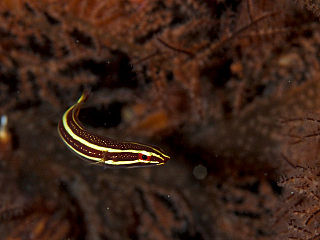
Lepadichthys is a genus of clingfishes native to the Indian and Pacific Oceans.
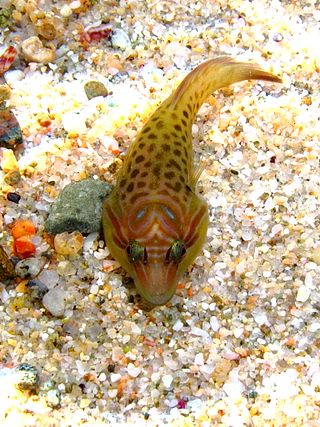
Lepadogaster is a genus of clingfishes native to the eastern Atlantic Ocean extending into the Mediterranean Sea. Lepadogaster belongs to class Actinopterygii. This means that they share many of the same characteristics as eels, ray-finned fish, and sea horses to name a few. The main characteristic of all of them though is having fin rays. These fin rays are made of webbed skin and are attached to portions of the body that connect fins to the bones. Lepadogaster species have a distinct difference in the formation of their dorsal and anal fins. While most other ray-finned fish spines, branched fin-rays, and middle radials, Lepadogaster species do not have these. Instead, they have cartilage in place of the mentioned features. These clingfish are mainly found near the rocky coasts and inside intertidal zones. Lepadogaster is known mostly as a clingfish, meaning that it spends most of its time attached to the surface of rocks.
Pherallodiscus is a genus of clingfishes native to the central eastern Pacific Ocean along the coast of Mexico. Based on genetic studies the genus should be merged into Gobiesox.
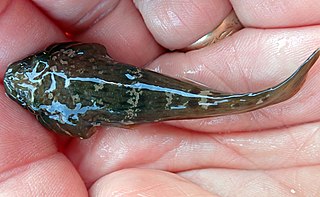
Trachelochismus is a genus of clingfishes endemic to the shores of New Zealand, with currently three recognized species:

Lepadogaster candolii, common name Connemarra clingfish, is a species of fish in the genus Lepadogaster. It occurs in the Eastern Atlantic from the British Isles south to Madeira and the Canary Islands and into the western Mediterranean and the Black Sea. The specific name candolii honours the Swiss botanist Augustin Pyramus de Candolle (1778-1841) and has various spellings: candolii, candolei, candollei, and decandollii, but only the first one is correct. Some workers have found that L. candolii is not closely related to the other two species in the genus Lepadogaster and have proposed the placing of this species in the revived monotypic genus Mirbelia Canestrini, 1864, at least until more definitive taxonomic studies can be undertaken.
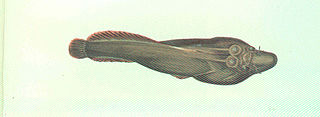
Lepadogaster purpurea, the Cornish sucker, is a species of clingfish from the family Gobiesocidae. It is found in the eastern North Atlantic Ocean and in the Mediterranean Sea.

Diplecogaster bimaculata, the two-spotted clingfish, is a species of fish in the family Gobiesocidae found in Black Sea, Mediterranean Sea and Atlantic Ocean where it is found on rocks and among seagrass or shell beds.
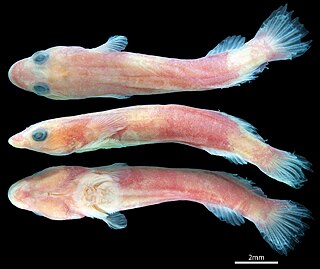
Flexor is a genus of clingfish from the family Gobiesocidae. It is a monotypic genus, the sole member of which Flexor incus was described in 2018 by Kevin W. Conway, Andrew L. Stewart and Adam P. Summers from type specimens collected on Raoul Island and L’Esperance Rock in the Kermadec Islands. An unknown species of clingfish was known to occur in the Kermadecs and it had been provisionally assigned to the genus Aspasmogaster. When examined, the specimens proved to belong to a new genus which they name Flexor, in reference to the flexibility of clingfishes, and incus, a reference to the anvil-like shape of the type locality, Raoul Island.

Opeatogenys gracilis is a species of clingfish from the family Gobiesocidae which is found in the Mediterranean Sea and in the eastern Atlantic Ocean. Suggested common names for this species are the pygmy clingfish and the seagrass clingfish.
















